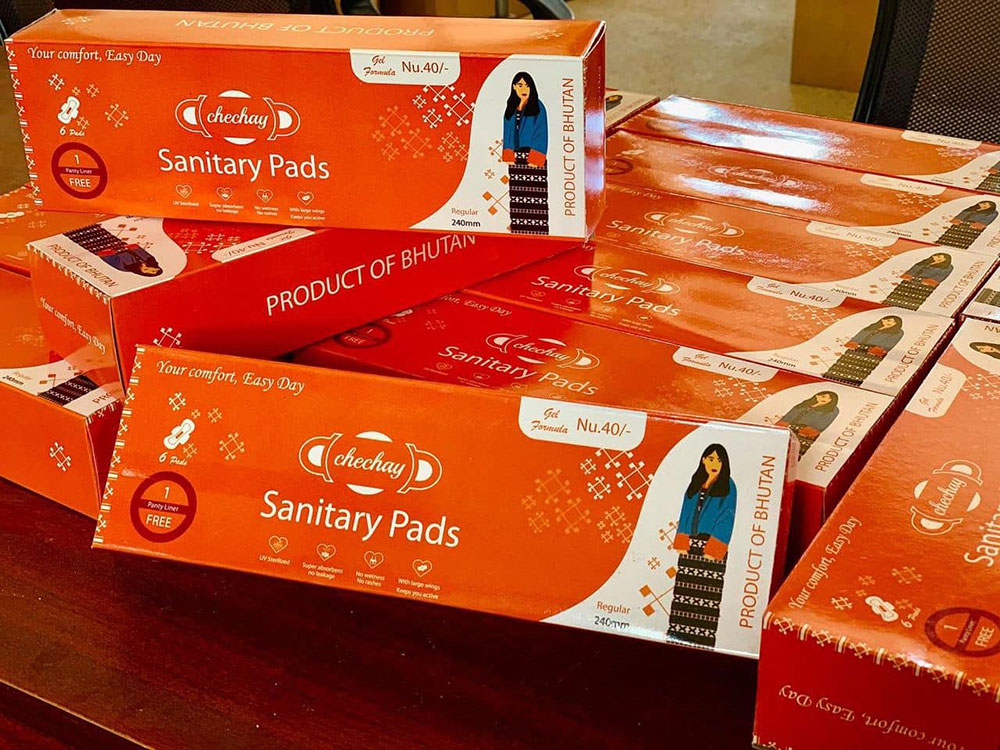Dechen Dolkar
The disposal of sanitary pads remains a major challenge in the community, posing threats to the environment and human health in spite of numerous initiatives to address the problem.
Considering the number of sanitary pads used per menstrual cycle, the average number of cycles per year, and the population size, Bhutan generates approximately 1.4 metric tonnes of menstrual waste nationwide in a day, which amounts to about 510 metric tonnes in a year.
It is estimated that each person produces 2kgs of menstrual waste per month.
The disposal of sanitary pads can have harmful impacts on the environment. Most sanitary pads contain plastic materials, including the absorbent core, back sheet, and packaging.

Officials from the Department of Environment and Climate Change under the Ministry of Energy and Natural Resources said that these plastic components can persist in the environment for hundreds of years, contributing to plastic pollution.
In addition, the officials stated that improper disposal of menstrual waste can pose health risks to waste handlers, sanitation workers, and the general public.
“Handling used menstrual products without appropriate protection can expose individuals to potential pathogens and bloodborne diseases, including environmental contamination and the spread of diseases. It is essential to consider the well-being and safety of those involved in waste management processes,” officials said.
Proper disposal
Sanitary pads should not be flushed down the toilet as they can cause blockages in sewerage systems and contribute to sewage and environmental pollution.
The officials from the Department of Environment and Climate Change said that the recommended method of disposal is to wrap the used pad in biodegradable materials such as toilet or tissue paper or newspaper and dispose of it in a covered bin designated for regular waste.
The officials said that about a year ago, they received some proposals on mini electric incinerators for sanitary pads. “Burning menstrual waste in these incinerators emits potentially harmful fumes and produces ash residue that requires appropriate disposal.”
In addition, the proliferation of such machines in schools, homes, businesses, and communities would have a significant and irreversible impact on the environment and human health.
Initiative for better disposal
Schools face challenges in the disposal of menstrual waste since they produce a large amount of it.
Deki Tshering, the Deputy Chief Programme Officer under the Division of Health and Wellbeing in the Department of Education Programme, said that the ministry has now appointed and trained school health coordinators on menstrual hygiene.
She said that in schools, the only option for menstrual waste disposal is to dispose of it directly in bins, which are then collected by waste collector tractors and disposed of in designated areas.
She also said that separate bins are allocated for the disposal of menstrual waste in schools.
Deki Tshering said that in some schools, separate toilets called changing rooms for girls during the menstrual cycle have been constructed.
She added that they have also distributed red dot bags in schools and communities for the separate disposal of used sanitary pads.
Yanchen Dema, the health coordinator of Babesa Primary School, said that the school keeps emergency sanitary pads, and students can access them whenever they need them.
She said that in Babesa Primary School, students directly dispose of menstrual waste in the septic tank.
“Now the students feel comfortable attending school during menstruation with the redesigning of toilet facilities in schools to include changing rooms for girls,” she said.
However, in Sonamthang Central School in Zhemgang, the students dispose of menstrual waste in separate bins.
The Principal, Rinzin Wangdi, said that the school faces challenges in disposing of menstrual waste.
He explained that for day scholar students, menstrual waste is collected in a bin and disposed of in pits. For border girls, it is collected in a sack, and tractors come weekly to collect the waste.
Eco-friendly menstrual products
It is essential to consider the environmental impact of menstrual waste and promote sustainable alternatives. Encouraging the use of reusable menstrual products, such as menstrual cups or cloth pads, can significantly reduce the amount of waste generated.
Deki Tshering said that the ministry has distributed both reusable and disposable sanitary pads in schools and institutions.
She mentioned that students prefer disposable pads since they are more convenient for them.
The founder of Zamin Friends Forever, Karma Yogini, said that so far, they have distributed reusable sanitary pads to more than 10,000 students in schools.
She explained that they encourage every girl to use reusable sanitary pads during certain periods of the menstrual cycle. “They can be used during the light cycle, and disposable sanitary pads can be used during the heavy cycle initially.”
“In the olden days, our parents used reusable sanitary pads,” she said.
Advocating for improved waste management infrastructure and facilities, along with proper education and awareness, can help address the environmental challenges associated with menstrual waste.
Photo: Locally manufactured menstrual products are cheaper and eco-friendly options


